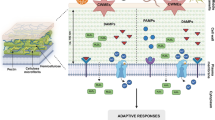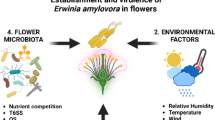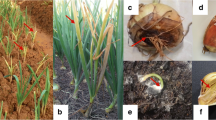Abstract
In recent years, spotting of ray florets of gerbera flowers has become an important problem. This type of small necrotic lesions may occur before, but especially shortly after harvesting the flowers.Botrytis cinerea was easily isolated from such lesions.
Inoculation withB. cinerea only gave typical necrotic lesions, when dry conidia were dusted on the flowers with a short period of high rh after inoculation. At 18–25 °C a high rh for at least 5 hours was necessary. Rotting of ray florets and receptacles byB. cinerea occurred when inoculated flowers were kept wet for a few days.
Spots consist of one to several necrotic, usually epidermal cells. A single conidium could give rise to a necrotic lesion after germination. Germination of conidia and lesion formation occurred between 4 and 25 °C; at 30 °C, germination and lesion formation did not occur. Between 18 and 25 °C, many lesions became visible within 1 day after inoculation; at 4 °C it took 2 to 3 days before lesions could be seen. If kept dry, conidia ofB. cinerea remained ungerminated on ray florets of gerbera flowers and could be removed from the ray florets. Within 1 day at high rh, germination occurred and lesions were produced. Conidia ofB. cinerea, stored dry, were able to survive much longer than the lifetime of a gerbera flower. Even after storage at room temperature for up to 14 months, some conidia were able to germinate in vitro and on ray florets and induce the formation of lesions. Addition of gerbera pollen diffusate stimulated germination and lesion formation.
Samenvatting
De laatste jaren komt het verschijnsel van het optreden van kleine necrotische plekken (‘smet’) op de lintbloemen van gerberabloemen steeds vaker voor. Deze necrosen zijn waarneembaar vóór, maar vooral kort na de oogst. Uit de necrotische plekjes kon de schimmelBotrytis cinerea gemakkelijk geïsoleerd worden.
Inoculatie van gerberabloemen metB. cinerea leidde alleen tot de vorming van dergelijke lesies als gebruik werd gemaakt van droge sporen van de schimmel en als na inoculatie de relatieve luchtvochtigheid een aantal uren hoog was. Tussen 18 en 25 °C diende deze periode minimaal 5 uren te zijn.B. cinerea kon de bloemen ook geheel doen verrotten, vooral als de geïnoculeerde bloemen een aantal dagen bij 4 °C nat gehouden werden, bij een hogere inoculumdichtheid of na toediening van voedingsstoffen bij inoculatie van de bloemen.
De necrotische plekjes bestonden veelal uit één tot enkele bruingekleurde epidermiscellen. Een dergelijke necrose kon reeds door één spore worden veroorzaakt.
Kieming van de sporen en lesievorming traden op tussen 4 °C (de laagste temperatuur die in de proeven is gebruikt) en 25 °C. Bij 30 °C vond geen kieming plaats en werden geen lesies gevormd. Tussen 18 en 25 °C werden veel lesies zichtbaar binnen 24 uur na inoculatie; bij 4 °C duurde dat 2 tot 3 dagen. Mits de sporen droog bleven, konden zij in ongekiemde toestand op bloemblaadjes blijven liggen en konden ook zij weer gemakkelijk daarvan verwijderd worden. Zodra de luchtvochtigheid hoog werd gedurende een aantal uren, trad kieming op en werden lesies gevormd.
Sporen vanB. cinerea konden veel langer in leven blijven dan gerberabloemen. Droog bewaard bij kamertemperatuur, bleek 1 tot 2% van de sporen zelfs na 14 maanden nog in staat te kiemen, zowel in vitro als op bloemblaadjes van gerbera, en de vorming van lesies te induceren. Toediening van diffusaat van stuifmeel van gerbera stimuleerde de kieming en het optreden van lesies.
Similar content being viewed by others
References
Alderman, S.C., Lacy, M.L. & Everts, K.L., 1985. Influence of interruptions of dew period on numbers of lesions produced on onion byBotrytis squamosa. Phytopathology 75: 808–810.
Bakker, A.G.M., 1986. Najaarsproblemen in de gerberateelt. Vakblad voor de Bloemisterij 41 (31): 20–21.
Blakeman, J.P., 1980. Behaviour of conidia on aerial plant surfaces. In: Coley-Smith, J.R., Verhoeff, K. & Jarvis, W.R. (Eds), The biology ofBotrytis. Academic Press, London, p. 115–151.
Chu Chou, M. & Preece, T.F., 1968. The effect of pollen grains on infections caused byBotrytis cinerea Fr. Annals of Applied Biology 62: 11–22.
Coley-Smith, J.R., 1980. Sclerotia and other structures in survival. In: Coley-Smith, J.R., Verhoeff, K. & Jarvis, W.R. (Eds), The biology ofBotrytis. Academic Press, London, p. 85–114.
Erb, K., Gallegly, M.E. & Leach, J.G., 1973. Longevity of mycelium ofColletotrichum lindemuthianum in hypocotyl tissue of resistant and susceptible bean cultivars. Phytopathology 63: 1334–1335.
Kolattukudy, P.E., 1985. Enzymatic penetration of the plant cuticle by fungal pathogens. Annual Review of Phytopathology 23: 223–250.
Lingappa, B.T. & Lockwood, J.L., 1963. Direct assay of soils for fungistasis. Phytopathology 53: 529–531.
McClellan, W.D. & Hewitt, W.B., 1973. Early Botrytis rot of grapes: time of infection and latency ofBotrytis cinerea Pers. inVitis vinifera L. Phytopathology 63: 1151–1157.
Marlot, R., 1984. La protection phytosanitaire des principales espèces des fleurs coupées: le gerbera. L'Horticulture Français, Avril 1984: 17–19.
Powelson, R.L., 1960. Initiation of strawberry fruit rot caused byBotrytis cinerea in vitro. Phytopathology 50: 491–494.
Salinas, J. & Schot, C.P., 1987. Morphological and physiological aspects ofBotrytis cinerea. Mededelingen van de Faculteit Landbouwwetenschappen Rijksuniversiteit Gent 52: 771–776.
Salinas, J., Warnaar, F. & Verhoeff, K., 1986. Production of cutin hydrolyzing enzymes byBotrytis cinerea in vitro. Journal of Phytopathology 116: 299–307.
Taylor, J.C. & Muskett, A.E., 1959. Grey mould of chrysanthemum flowers. Plant Pathology 8: 57–59.
Verberkt, H., 1986. Tijdens verwerking, bewaring en transport waken voorBotrytis. Vakblad voor de Bloemisterij 41 (31): 14–15.
Verhoeff, K., 1970. Spotting of tomato fruits caused byBotrytis cinerea. Netherlands Journal of Plant Pathology 76: 219–226.
Verhoeff, K., 1980. The infection process and host-pathogen interactions. In: Coley-Smith, J.R., Verhoeff, K. & Jarvis, W.R. (Eds), The biology ofBotrytis. Academic Press, London, p. 153–180.
Author information
Authors and Affiliations
Rights and permissions
About this article
Cite this article
Salinas, J., Glandorf, D.C.M., Picavet, F.D. et al. Effects of temperature, relative humidity and age of conidia on the incidence of spotting on gerbera flowers caused by Botrytis cinerea. Netherlands Journal of Plant Pathology 95, 51–64 (1989). https://doi.org/10.1007/BF02000882
Accepted:
Issue Date:
DOI: https://doi.org/10.1007/BF02000882




